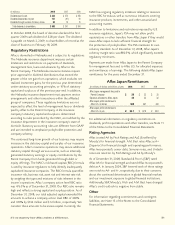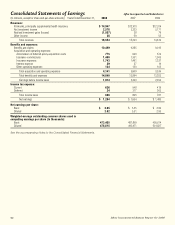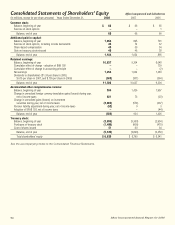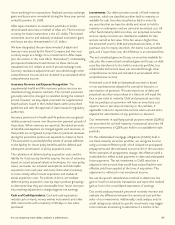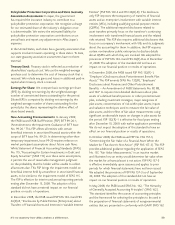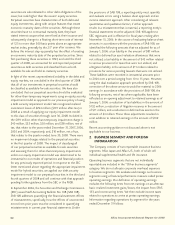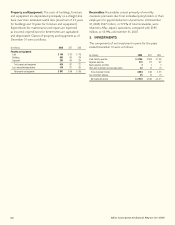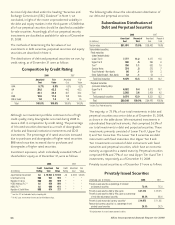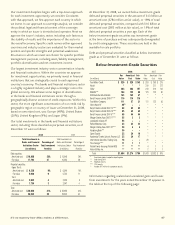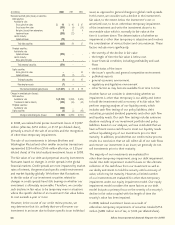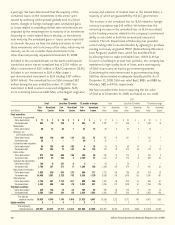Aflac 2008 Annual Report Download - page 64
Download and view the complete annual report
Please find page 64 of the 2008 Aflac annual report below. You can navigate through the pages in the report by either clicking on the pages listed below, or by using the keyword search tool below to find specific information within the annual report.
60 Aflac Incorporated Annual Report for 2008
is effective as of November 15, 2008. The adoption of this
standard did not have an effect on our financial position or
results of operations.
In March 2008, the FASB issued SFAS No. 161, “Disclosures
about Derivative Instruments and Hedging Activities — an
amendment of FASB Statement No. 133” (SFAS 161). FASB
Statement No. 133, Accounting for Derivative Instruments
and Hedging Activities , establishes, among other things, the
disclosure requirements for derivative instruments and for
hedging activities. This statement amends and expands the
disclosure requirements of Statement 133 with the intent
to provide users of financial statements with an enhanced
understanding of how and why an entity uses derivative
instruments, how derivative instruments and related hedged
items are accounted for under Statement 133 and its related
interpretations, and how derivative instruments and related
hedged items affect an entity’s financial position, financial
performance, and cash flows. To meet those objectives, this
statement requires qualitative disclosures about objectives
and strategies for using derivatives, quantitative disclosures
about fair value amounts of and gains and losses on derivative
instruments, and disclosures about credit-risk-related
contingent features in derivative agreements. SFAS 161 is
effective for financial statements issued for fiscal years and
interim periods beginning after November 15, 2008. We do
not expect the adoption of this standard to have an effect on
our financial position or results of operations.
In December 2007, the FASB issued SFAS No. 160,
“Noncontrolling Interests in Consolidated Financial Statements
— an amendment of ARB No. 51” (SFAS 160). The purpose
of SFAS 160 is to improve relevance, comparability, and
transparency of the financial information that a reporting entity
provides in its consolidated financial statements by establishing
accounting and reporting standards for the noncontrolling
interest in a subsidiary and for the deconsolidation of a
subsidiary. SFAS 160 is effective for fiscal years beginning on or
after December 15, 2008, with earlier adoption prohibited. We
do not expect the adoption of this standard to have an effect
on our financial position or results of operations.
In February 2007, the FASB issued SFAS No. 159, “The Fair
Value Option for Financial Assets and Financial Liabilities —
including an amendment of FASB Statement No. 115” (SFAS
159). SFAS 159 allows entities to choose to measure many
financial instruments and certain other items at fair value.
The majority of the provisions of this standard apply only to
entities that elect the fair value option (FVO). The FVO may
be applied to eligible items on an instrument-by-instrument
basis; is irrevocable unless a new election date occurs; and
may only be applied to an entire financial instrument, and not
portions thereof. This standard requires a business enterprise
to report unrealized gains and losses on items for which
the FVO has been elected in earnings at each subsequent
reporting date. SFAS 159 is effective for fiscal years beginning
after November 15, 2007, with earlier application permitted
under limited circumstances. In connection with our adoption
of SFAS 159 as of January 1, 2008, we did not elect the FVO
for any of our financial assets and liabilities. Accordingly, the
adoption of this standard did not have an impact on our
financial position or results of operations.
In September 2006, the FASB issued SFAS No. 158,
“Employers’ Accounting for Defined Benefit Pension
and Other Postretirement Plans, an amendment of FASB
Statements No. 87, 88, 106, and 132(R)” (SFAS 158).
We adopted the recognition and measurement date
provisions of this standard effective December 31, 2006.
In the consolidated statements of shareholders’ equity
for the year ended December 31, 2006, we included in
2006 other comprehensive income a cumulative transition
adjustment, net of income taxes, of $44 million from the
adoption of SFAS 158. This cumulative effect adjustment
was properly included in the rollforward of accumulated
other comprehensive income for the year, but it should not
have been included in other comprehensive income for the
year. Total comprehensive income for the year, not including
the transition adjustment for SFAS 158, was $996 million.
Management concluded that the transition adjustment was
not material to the financial statements taken as a whole.
We have adjusted other comprehensive income for the
year ended December 31, 2006, to properly reflect the
transition adjustment as a direct charge to accumulated other
comprehensive income. The effect of recording the transition
adjustment through other comprehensive income and the
subsequent adjustment to reflect the amounts as a direct
charge to accumulated other comprehensive income did not
have any impact on the consolidated statements of earnings,
the consolidated balance sheets, the consolidated statements
of shareholders’ equity or the consolidated statements of cash
flows for any periods presented.
In September 2006, the FASB issued SFAS No. 157, “Fair
Value Measurements” (SFAS 157). SFAS 157 defines fair
value, establishes a framework for measuring fair value under
GAAP, expands disclosures about fair value measurements
and specifies a hierarchy of valuation techniques based
on whether the inputs to those valuation techniques are
observable or unobservable. Observable inputs reflect market
data corroborated by independent sources while unobservable
inputs reflect market assumptions that are not observable
in an active market or are developed internally. These two
types of inputs create three valuation hierarchy levels. Level 1



